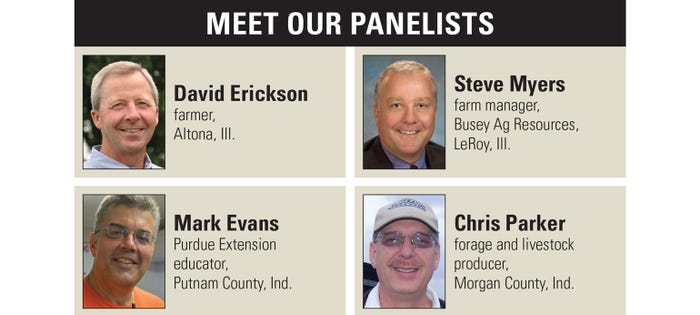
I bought 80 acres five years ago. It has 20 acres of native timber. It has never been cut, at least in anyone’s memory. Is now a good time to sell off some timber? I could certainly use the cash flow. How would I go about doing that? How can I make timber a resource for the future?
The Profit Planners panel includes David Erisckson, farmer, Altona, Ill.; Mark Evans, Purdue University Extension educator, Greencastle, Ind.; Steve Myers, farm manager, Busey Ag Resources, Leroy, Ill.; and Chris Parker, cattle, timber and forage producer, Morgantown, Ind.
Erickson: This could be a very good idea for some additional income. I would encourage you to seek the assistance of qualified specialists to help you with this specific need. If there are other area landowners with similar land who have harvested trees, they would be good resources to begin your education. The University of Illinois Extension has forestry resources available. The Illinois Department of Natural Resources compiles a list of timber buyers that is available on its website. Identify some local names from that list and begin to contact them for their interest in your property and their terms of engagement. Always ask for references, and make sure they have appropriate insurance and bonding.
Evans: If you have timber that hasn’t been harvested in 20 or 30 years, at least a minimal maintenance harvest is in order. Timber prices are strong for better-quality lumber and veneer. Prices are weak for lower-quality lumber. So if you have junk trees and a cleanup harvest, you may not be in for the windfall at first harvest. But this will make for better harvests down the road. Too many people, in search of money, sell a 20-inch-diameter tree that, if left a few more years, would result in much more return.
Contact your Indiana Department of Natural Resources forester and walk the woods to get a feel for timber species, quality and maturity. An IDNR district forester can’t mark your woods for sale or suggest a sale price. A consultant can be hired for those purposes. I would certainly suggest a bid sale. It’s not uncommon for bids to vary by tens of thousands of dollars on the very same lot of lumber up for sale.
Also, contact your local USDA offices to investigate signing up for cost-share for timber stand improvement. That allows you to choose to manage the 20 acres rather than let happenstance occur. In Indiana, a classified forest program option could lower assessed value of that 20 acres to $1 per acre. Ask your DNR forester for details.
Myers: Consider professional help either through the Natural Resources Conservation Service or a private forester. To not harvest timber that is “ready” could prove wasteful. A timber crop requires management, and these professionals can help you analyze what you have, as well as point you in the right direction for marketing.
In general, heathy timber stands do involve harvesting and selling mature trees, management of invasive species, and thinning.
Parker: An excellent starting step would be to contact your IDNR district forester and take a walk in the woods with him or her to get an overview of timber species, quality and maturity. If a sale is warranted, I’d suggest hiring a consultant forester to mark and conduct a bid sale. After the sale and harvest, a good idea would be to invest in timber stand improvement. Purdue Extension Bulletin FNR-111 would also give you pertinent ideas.

About the Author(s)
You May Also Like




